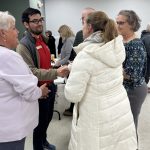Showcasing People and Places of Sherman Park
UWM architecture field school focuses on nine blocks in Sherman Park this summer.
Arijit Sen, associate professor of Architecture at UWM, began the project in 2012, with the help of Historic Milwaukee, UW-Milwaukee and UW-Madison, among others. “Every year we collect positive stories of neighborhoods — stories that are usually not heard — and most of them are stories of stewardship and caring.”
The fundamental idea of the five-week course is that that residents of Milwaukee’s neighborhoods have a deep sense of caring for their neighborhoods and their neighbors. The first neighborhood examined was Thurston Woods, followed by the Historic Water Tower neighborhood. The goal for the next three years was to compare neighborhoods across North Avenue in Washington Park. The basic assumption behind these comparisons is that in every neighborhood there are people who serve, of their own accord, as stewards.
Stewardship comes through multiple local acts of caring, and maintaining homes for the benefit of the greater community. “There are some central common stewardship ethics that we share, and our goal was to learn from the neighbors and community residents some of these ethics of stewardship, so that we can bring that to the practice of architecture, planning and geography,” Sen said.
Though the school has moved to a new neighborhood after three years in Washington Park, Sen says it has never completely moved out. Mavis McCallum, one of the first community members in the Field School who met Sen in Thurston Woods in 2012, once told him, “Look, you have to stay in a neighborhood long enough.” Sen said, “It’s very hard to move out of a neighborhood when you’ve made friends.”
This year has taken a particularly grassroots approach, according to Field School student Chelsea Wait. “In the past we have just focused on individual houses and people who live there as well as a couple community institutions. This year we’ve really tried to go for stories of neighborliness, whether that is loaning your drill to a neighbor, or sitting in a chair on the lawn and keeping an eye on the street, or … even at a bare minimum waving at people.”
Although the Field School is technically an architecture program, it attracts people from diverse backgrounds and different levels of experience.
Tesia Zietlow, another Field School student, had been living abroad before she searched the keywords “architecture” and “summer” online, and read Sen’s blog page and some his research on other websites. “We’re not all architects. We’re not even all students, and we’re at different levels; some of us just coming into undergrad, some [with] master’s, some Ph.Ds, and so getting all these perspectives from all these disciplines is really, really cool,” Zietlow said.
The first week of the program consists of drawing and measuring a house. In the second week, students research archives in the public library, City Hall, the City Records Office and Milwaukee County Historical Society, and in the third week they interview about 30 people. The last two weeks are spent perfecting the storylines and producing storyboards, videos, blog posts and other materials.
The Field School is planning an exhibition at which students will present their work. It will take place between 5 p.m. and 8 p.m. on Aug. 12 at the Old Finney Library, 4243 W. North Ave.
This story was originally published by Milwaukee Neighborhood News Service, where you can find other stories reporting on eighteen city neighborhoods in Milwaukee.





















